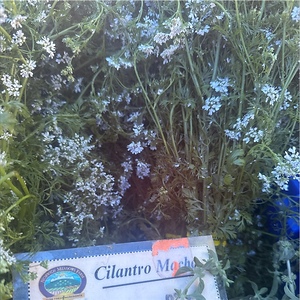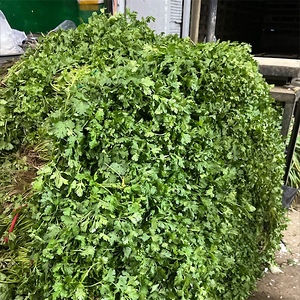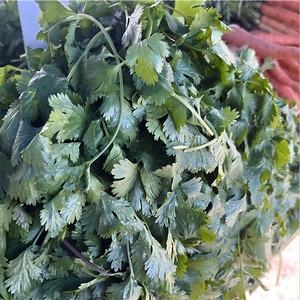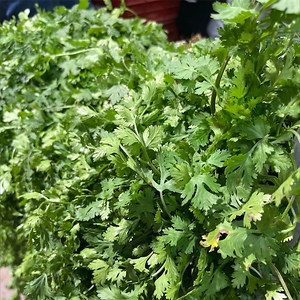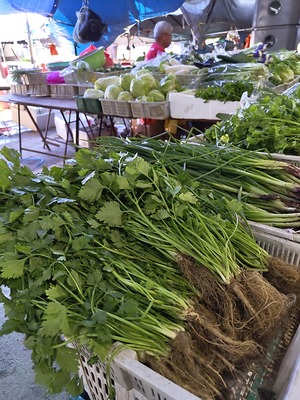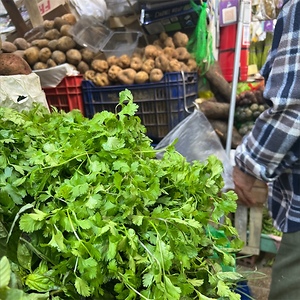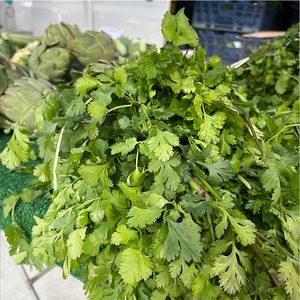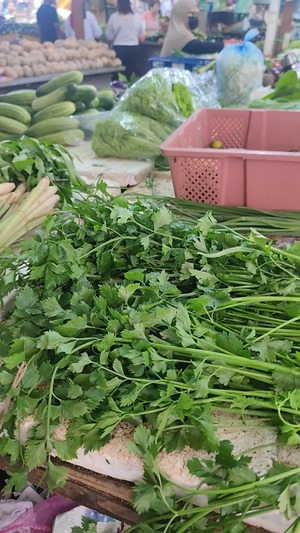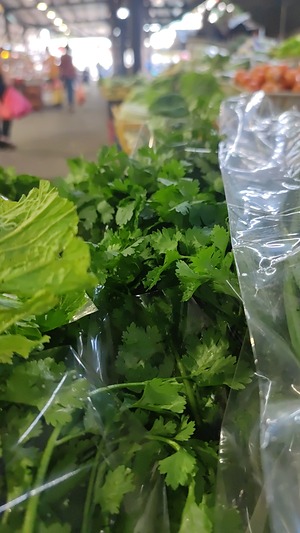


Cilantro
Estimated Inventory, 30 ct : 0
Description/Taste
Cilantro is comprised of small leaves attached to long and slender green stems. The leaves vary in size, with the base leaves being larger, while the leaves at the top of the stems are smaller and more delicate. The dark green leaves are generally broad, flat, and deeply lobed with feathery, serrated edges and a smooth and crisp consistency. In addition to the leaves, the pale green stems are edible and provide a crunchy, succulent texture. Cilantro has a sweet, vegetal, and pungent aroma and an earthy, herbaceous, and bright, grassy taste. The leaves often contain peppery, tangy, and citrus-like nuances, and to some palates, Cilantro bears an acrid and unpleasant soapy taste. Cilantro plants also produce edible light brown seeds, white flowers, and roots that are utilized in various culinary preparations.
Seasons/Availability
Cilantro is available year-round.
Current Facts
Cilantro, botanically classified as Coriandrum sativum, is the feathery leaves of an herbaceous plant belonging to the Apiaceae family. The name Cilantro is the Spanish descriptor for the leaves of the Coriander plant, and the aromatic herb can reach 30 to 50 centimeters in height, producing many broad and flat leaves along the slender stems. Coriander is an ancient herb that has been utilized medicinally and in culinary preparations since ancient times. The leaves, stems, roots, and seeds are edible, and throughout history, the leaves and seeds have been incorporated into cuisines worldwide. Cilantro is also known as Chinese parsley, Mexican parsley, and Fresh Coriander leaves, and the leaves are favored as a finishing flavor accent in both raw and cooked savory dishes. Globally, Cilantro is commercially cultivated and grown as a home garden cultivar. The leaves are sold fresh in bundles at markets, while the seeds are sold whole or crushed as a dried spice.
Nutritional Value
Cilantro is a good source of vitamin A to maintain healthy organ functioning, vitamin K to assist in faster wound healing, dietary fiber to regulate the digestive tract, and manganese. The leaves also contain vitamin C to strengthen the immune system and other antioxidants to reduce inflammation while protecting the cells against free radical damage. Cilantro has a polarizing flavor due to a natural chemical known as an aldehyde. This chemical is received as having a “soapy” taste to some consumers. The strength in which the aldehyde is perceived and detected is unique to each individual, creating a wide range of opinions regarding Cilantro and its aroma and flavor.
Applications
Cilantro is an aromatic herb well suited as an edible garnish or finishing flavor in savory dishes. The leaves can be lightly torn, chopped, or minced, added at the end of cooking to retain the herb’s bright and fresh flavor. Cilantro is widely incorporated in many cuisines, including Indian, North African, Mexican, Latin American, Middle Eastern, Caribbean, Greek, and Asian. The leaves can be sprinkled over soups, curries, and stews, tossed into stir-fries, cooked into omelets, or stirred into rice and noodle-based dishes. Cilantro can also be blended into sauces such as pesto, hot sauce, chopped into salsa, folded into creamy dips, or used as a flavoring in marinades, brines, and salad dressings. The fragrant leaves are popularly used in Mexican cuisine as a topping over tacos, enchiladas, and bean dips, and in Vietnamese cuisine, the leaves are combined into fried egg rolls and tossed over pho. Indian cuisine also uses Cilantro in samosas, vegetable side dishes, and chana masala, a chickpea curry. Beyond using the fresh leaves, Cilantro can be chopped, mixed into salt, and served as a flavor enhancer. Cilantro pairs well with meats such as poultry, duck, lamb, beef, and fish, tofu, scallions, red bell peppers, corn, tomatoes, ginger, mushrooms, jicama, potatoes, other herbs including mint, parsley, and basil, legumes, and yogurt. Whole, unwashed Cilantro will keep 5 to 7 days when stored upright in a glass of water and covered loosely with a plastic bag in the refrigerator. The leaves have a delicate nature and are recommended for immediate use to capture the best texture and flavor.
Ethnic/Cultural Info
In Ancient Egypt, the Coriander plant was viewed as a medicinal and culinary ingredient highly valued for maintaining health and providing energy. Coriander seeds were often placed in the tombs of Egyptian Pharaohs, including King Tutankhamen and Ramses II, as herbs were believed to help reduce fevers. Many Egyptians believed the Pharaohs could take these seeds into the afterlife to grow Coriander plants for medicinal and culinary purposes. Seeds were also used in tombs as a symbol for burial, resurrection, and new life. In addition to burials, Coriander was an herb used topically to reduce skin irritations and muscle pain and consumed internally to reduce chills, heat, and remove parasites. The leaves and seeds were also infused into wine or mixed into traditional culinary dishes, viewed as an aphrodisiac.
Geography/History
Cilantro, also known as Coriander, is an ancient herbaceous plant considered by experts to be native to Southern Europe and Asia Minor. In the Early Ages, the leafy plant and its seeds were spread to Egypt, Southwestern Europe, and Eastern Asia along trade routes. Cilantro was documented in Egyptian records as early as 2500 BCE, and the seeds were discovered in Israeli caves that have been dated to be over 8,000 years old. Cilantro leaves were also mentioned in Chinese agricultural writings in the 5th century and were utilized throughout the Greek and Roman Empires in medicinal and culinary preparations. In the 16th century, Spanish explorers were said to have introduced the herb to the New World, and in the 17th century, Cilantro was also brought with the British to the New World and widely planted, quickly becoming a staple crop throughout Latin America. Today Cilantro is cultivated worldwide and is available through fresh markets, distributors, grocers, and supermarkets.
Recipe Ideas
Recipes that include Cilantro. One



